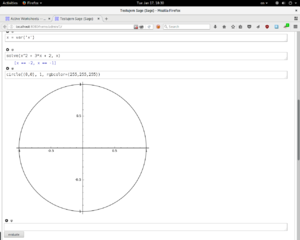Difference between revisions of "SageMath"
m |
|||
| Line 7: | Line 7: | ||
=== Install and configure layman and overlays === | === Install and configure layman and overlays === | ||
====Using layman==== | |||
The preferred way of getting sage-on-gentoo is layman. Make sure layman is installed with USE=git and correctly configured. You may find a guide for layman at: http://www.gentoo.org/proj/en/overlays/userguide.xml | |||
Update your layman list: | |||
{{console|body= | |||
###i## layman -L | |||
}} | |||
This overlay depends on | This overlay depends on science overlay. You will also need to add it, if not already installed: | ||
{{console|body= | |||
###i## layman -a science | |||
}} | |||
Finally add this overlay: | Finally, add this overlay: | ||
{{console|body= | |||
###i## layman -a sage-on-gentoo | |||
}} | |||
====Ebuilds unmask==== | |||
Before being able to install you may need to unmask the required ebuilds. You can use already-made files, shipped with overlay, such as: | |||
<code>sage-on-gentoo/package.unmask/sage</code> | |||
To use this file permanently, place symbolic link to this file into your <code>/etc/portage/package.unmask</code> directory: | |||
<path-to-layman> is usually <code>/var/lib/layman</code> (this path used to be <code>/usr/local/portage/layman</code> for older version of layman). | |||
{{console|body= | |||
###i## ln -s <path-to-layman>/sage-on-gentoo/package.unmask/sage /etc/portage/package.unmask/sage | |||
}} | |||
Notice, that in this example, portage's package.unmask is directory , make sure to apply masks entries according to your preferred way of masks handle (directory or a flat file). | |||
====Use flags==== | |||
Since Sage's ebuild requires its dependencies to be built with several USE- flags a standard package.use file is provided as well: | |||
{{console|body= | |||
###i## ln -s <path-to-layman>/sage-on-gentoo/package.use/sage /etc/portage/package.use/sage | |||
}} | |||
On a stable build installations you may also need following file: | |||
<path-to-layman> | {{console|body= | ||
###i## ln -s <path-to-layman>/sage-on-gentoo/package.use/sage-unstable /etc/portage/package.use/sage-unstable | |||
}} | |||
{{Note|With sage 6.8 a <code>99sage-doc-bin</code> file installed that makes it easy to use pre-built html documentation. This is recommended for ~arch users.}} | |||
Note | |||
====Installing Sage==== | |||
{{console|body= | |||
###i## emerge -va sage | |||
}} | |||
Please note that this will pull in a lot of dependencies. If you can not proceed with this step (because of circular dependencies, missing USE-flags, and so on) | Please, note that this will pull in a lot of dependencies. If you can not proceed with this step (because of circular dependencies, missing USE-flags, and so on), report this behavior. | ||
Revision as of 08:04, March 20, 2017
SageMath is mathematical software with features covering many aspects of mathematics, including algebra, combinatorics, numerical mathematics, number theory, and calculus.
Installation
There are two overlays that are needed to get Sage installed. The science-overlay and the sage-on-gentoo-overlay.
Install and configure layman and overlays
Using layman
The preferred way of getting sage-on-gentoo is layman. Make sure layman is installed with USE=git and correctly configured. You may find a guide for layman at: http://www.gentoo.org/proj/en/overlays/userguide.xml Update your layman list:
root # layman -L
This overlay depends on science overlay. You will also need to add it, if not already installed:
root # layman -a science
Finally, add this overlay:
root # layman -a sage-on-gentoo
Ebuilds unmask
Before being able to install you may need to unmask the required ebuilds. You can use already-made files, shipped with overlay, such as:
sage-on-gentoo/package.unmask/sage
To use this file permanently, place symbolic link to this file into your /etc/portage/package.unmask directory:
<path-to-layman> is usually /var/lib/layman (this path used to be /usr/local/portage/layman for older version of layman).
root # ln -s <path-to-layman>/sage-on-gentoo/package.unmask/sage /etc/portage/package.unmask/sage
Notice, that in this example, portage's package.unmask is directory , make sure to apply masks entries according to your preferred way of masks handle (directory or a flat file).
Use flags
Since Sage's ebuild requires its dependencies to be built with several USE- flags a standard package.use file is provided as well:
root # ln -s <path-to-layman>/sage-on-gentoo/package.use/sage /etc/portage/package.use/sage
On a stable build installations you may also need following file:
root # ln -s <path-to-layman>/sage-on-gentoo/package.use/sage-unstable /etc/portage/package.use/sage-unstable
With sage 6.8 a 99sage-doc-bin file installed that makes it easy to use pre-built html documentation. This is recommended for ~arch users.
Installing Sage
root # emerge -va sage
Please, note that this will pull in a lot of dependencies. If you can not proceed with this step (because of circular dependencies, missing USE-flags, and so on), report this behavior.
